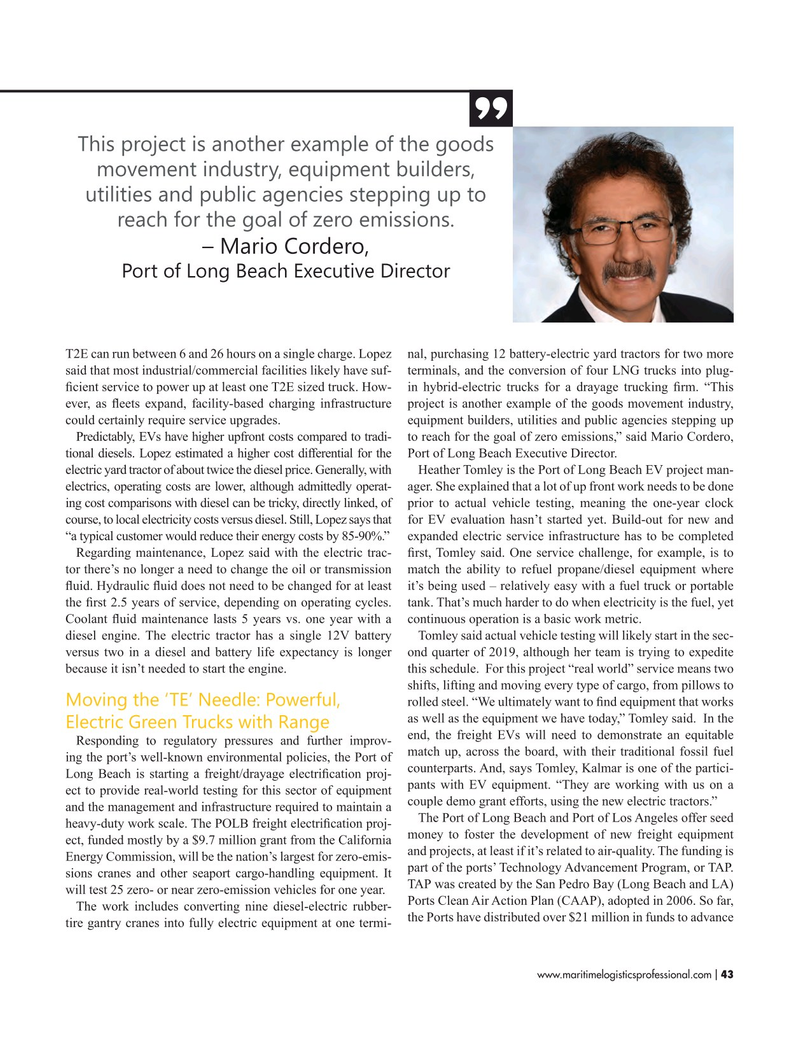
Page 43: of Maritime Logistics Professional Magazine (May/Jun 2018)
Container Ports
Read this page in Pdf, Flash or Html5 edition of May/Jun 2018 Maritime Logistics Professional Magazine
This project is another example of the goods movement industry, equipment builders, utilities and public agencies stepping up to reach for the goal of zero emissions.
– Mario Cordero,
Port of Long Beach Executive Director
T2E can run between 6 and 26 hours on a single charge. Lopez nal, purchasing 12 battery-electric yard tractors for two more said that most industrial/commercial facilities likely have suf- terminals, and the conversion of four LNG trucks into plug- fcient service to power up at least one T2E sized truck. How- in hybrid-electric trucks for a drayage trucking frm. “This ever, as feets expand, facility-based charging infrastructure project is another example of the goods movement industry, could certainly require service upgrades. equipment builders, utilities and public agencies stepping up
Predictably, EVs have higher upfront costs compared to tradi- to reach for the goal of zero emissions,” said Mario Cordero, tional diesels. Lopez estimated a higher cost differential for the Port of Long Beach Executive Director.
electric yard tractor of about twice the diesel price. Generally, with Heather Tomley is the Port of Long Beach EV project man- electrics, operating costs are lower, although admittedly operat- ager. She explained that a lot of up front work needs to be done ing cost comparisons with diesel can be tricky, directly linked, of prior to actual vehicle testing, meaning the one-year clock course, to local electricity costs versus diesel. Still, Lopez says that for EV evaluation hasn’t started yet. Build-out for new and “a typical customer would reduce their energy costs by 85-90%.” expanded electric service infrastructure has to be completed
Regarding maintenance, Lopez said with the electric trac- frst, Tomley said. One service challenge, for example, is to tor there’s no longer a need to change the oil or transmission match the ability to refuel propane/diesel equipment where fuid. Hydraulic fuid does not need to be changed for at least it’s being used – relatively easy with a fuel truck or portable the frst 2.5 years of service, depending on operating cycles. tank. That’s much harder to do when electricity is the fuel, yet
Coolant fuid maintenance lasts 5 years vs. one year with a continuous operation is a basic work metric.
diesel engine. The electric tractor has a single 12V battery Tomley said actual vehicle testing will likely start in the sec- versus two in a diesel and battery life expectancy is longer ond quarter of 2019, although her team is trying to expedite because it isn’t needed to start the engine. this schedule. For this project “real world” service means two shifts, lifting and moving every type of cargo, from pillows to
Moving the ‘TE’ Needle: Powerful, rolled steel. “We ultimately want to fnd equipment that works as well as the equipment we have today,” Tomley said. In the
Electric Green Trucks with Range end, the freight EVs will need to demonstrate an equitable
Responding to regulatory pressures and further improv- ing the port’s well-known environmental policies, the Port of match up, across the board, with their traditional fossil fuel counterparts. And, says Tomley, Kalmar is one of the partici-
Long Beach is starting a freight/drayage electrifcation proj- ect to provide real-world testing for this sector of equipment pants with EV equipment. “They are working with us on a couple demo grant efforts, using the new electric tractors.” and the management and infrastructure required to maintain a
The Port of Long Beach and Port of Los Angeles offer seed heavy-duty work scale. The POLB freight electrifcation proj- money to foster the development of new freight equipment ect, funded mostly by a $9.7 million grant from the California and projects, at least if it’s related to air-quality. The funding is
Energy Commission, will be the nation’s largest for zero-emis- sions cranes and other seaport cargo-handling equipment. It part of the ports’ Technology Advancement Program, or TAP.
TAP was created by the San Pedro Bay (Long Beach and LA) will test 25 zero- or near zero-emission vehicles for one year.
Ports Clean Air Action Plan (CAAP), adopted in 2006. So far,
The work includes converting nine diesel-electric rubber- the Ports have distributed over $21 million in funds to advance tire gantry cranes into fully electric equipment at one termi- www.maritimelogisticsprofessional.com 43
I

 42
42

 44
44
